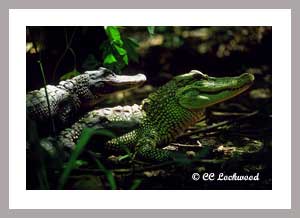By: CC Lockwood

The American alligator,Alligator mississippiensis, is a fascinating creature. I often say that the gator is better designed than a stealth bomber as it’s totally suited for and adapted to its wetland habitat. The gator can swim with ease and speed and remain submerged for long periods. It can put its nose and eyes up like a periscope of a submarine, and be totally camouflaged. The alligator can crawl through boot sucking mud and sharp saw grasses. It can eat almost anything and survive without food for one year. Mosquitoes don’t bother it. No wonder this reptile has survived in one form or another for the last two hundred million years, since the time of the dinosaurs. I saw the need to produce a book about this wetland carnivore.
I have been professionally photographing wildlife and their habitats since 1971, much of the time in swamps and marsh, which has resulted innumerous bookson the subject. During this time I have photographed many alligators, but in reviewing these photographs, there were two basic poses. Either sunning on a bank on the bayou or swimming in a pond covered in duckweed. Good pictures but not the diversity needed to produce a whole book.
Once I started researching the American alligator and brainstorming photo ideas, the possibility of a book seemed more plausible.
Story Board. Chapter 1. Wild Alligators: including breeding, nest building, eggs, hatching, babies, their protective mothers, feeding, danger to humans and large alligators. Chapter 2. Research and Biology: including capturing and doing research especially the night work, farms and captive breeding, nuisance alligator hunters.
Chapter 3. Alligator Tourism: including swamp tours, feeding shows, alligator wrestling, trinkets, mascots, and souvenirs.
Once on the road, I began I realizing that the incredible amount of material on the alligator could keep this project going on indefinitely. Every shot yielded three more ideas and places to go. After one year on the road and 390 rolls of film, I realized I would just have to say, “Enough.”
Choosing equipment and film for this project was crucial to its success. For equipment, I used the Nikon F-5 with Nikon lenses ranging from 16mm to 500mm. For film, I used Fuji, Velvia, Provia, and Provia 400 on some of the night work.
One of the most useful lenses on this project was the Nikon ED AF VR-Nikon 80-400mm f4.5-5.6D, due to its ability to perform in high action situations. Working from airboats with biologists catching alligators is a fast paced, exciting operation. I also had limited space. The vibration reduction made up for the lack of space to set up a tripod and the 80-400 focal length saved time from switching lenses.
I was very skeptical about this vibration reduction lens when I first heard about. I wasn’t interested enough to even try one out. However, I changed my mind when Michael Reichmann used the Canon version of this lens to photograph a desert bighorn ram from a moving raft on one of my Grand Canyon Trips. After seeing the results, I immediately purchased one and felt it would be perfect for the alligator project. It was.

I used wide angles on the charging mother gator shot and intended to get a camera on a pole with remote and release to get up close and personal with the reptile jaws. However, with the help of a biologist, I found that I could photograph safely with a wide angle hand held as they fended off the gator. I did finish the project with all five fingers.
Although alligators have caused only 12 human deaths in recorded history, they are dangerous creatures with approximately 78 teeth that can chomp down with a bite pressure of 3000 pounds per square inch. Keep your distance and always be careful around these efficient hunters. They can easily take you arm off as seen in the picture on Page 12 in my book. The most injuries come from people who handle alligators a lot such as the wrestler in Florida tourist attractions. Many of the attractions are listed in the appendix of my book. Most are great photo locations.
Good spots to photograph wild alligators are in Florida, atEverglades National ParkandWakulla Springs State Park, in Louisiana, on the Nature Trail at theSabine National Wildlife Refugeand inJean Lafitte National Park, in Georgia, at theOkefenokee Swampand just about any park or refuge in the southeast that has waterways. You can visitthe exhibitand also seethe bookat your favorite bookstore.
© 2002 CC Lockwood
CC Lockwood is a prolific wildlife and nature photographer with 8 photographic books to his credit.
You May Also Enjoy...
Africa Confirmation
Thank you for your registration. Once we have received your deposit you will be guaranteed the space or spaces that you have reserved. Your space

